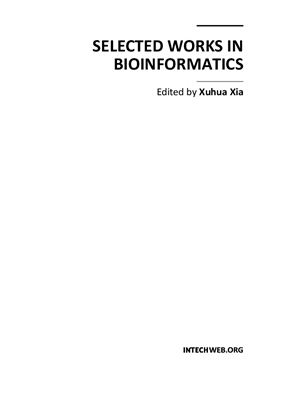InTech. 2011. 190 p.
This book consists of nine chapters covering a variety of bioinformatics subjects, ranging from database resources for protein allergens, unravelling genetic determinants of complex disorders, characterization and prediction of regulatory motifs, computational methods for identifying the best classifiers and key disease genes in large-scale transcriptomic and proteomic experiments, functional characterization of inherently unfolded proteins/regions, protein interaction networks and flexible protein-protein docking. The computational algorithms are in general presented in a way that is accessible to advanced undergraduate students, graduate students and researchers in molecular biology and genetics. The book should also serve as stepping stones for mathematicians, biostatisticians, and computational scientists to cross their academic boundaries into the dynamic and ever-expanding field of bioinformatics.
Contents
Allergen Bioinformatics: Recent Trends and Developments
Family Based Studies in Complex Disorders: The Use of Bioinformatics Software for Data Analysis in Studies on Osteoporosis
Guide to Genome-Wide Bacterial Transcription Factor Binding Site Prediction Using OmpR as Model
Understanding LiP Promoters from Phanerochaete chrysosporium: A Bioinformatic Analysis
Prediction and Experimental Detection of Structural and Functional Motifs in Intrinsically Unfolded Proteins
Relaxed Linear Separability (RLS) Approach to Feature (Gene) Subset Selection
Disease Gene Prioritization
Exploiting Protein Interaction Networks to Unravel Complex Biological Questions
Flexible Protein-Protein Docking
This book consists of nine chapters covering a variety of bioinformatics subjects, ranging from database resources for protein allergens, unravelling genetic determinants of complex disorders, characterization and prediction of regulatory motifs, computational methods for identifying the best classifiers and key disease genes in large-scale transcriptomic and proteomic experiments, functional characterization of inherently unfolded proteins/regions, protein interaction networks and flexible protein-protein docking. The computational algorithms are in general presented in a way that is accessible to advanced undergraduate students, graduate students and researchers in molecular biology and genetics. The book should also serve as stepping stones for mathematicians, biostatisticians, and computational scientists to cross their academic boundaries into the dynamic and ever-expanding field of bioinformatics.
Contents
Allergen Bioinformatics: Recent Trends and Developments
Family Based Studies in Complex Disorders: The Use of Bioinformatics Software for Data Analysis in Studies on Osteoporosis
Guide to Genome-Wide Bacterial Transcription Factor Binding Site Prediction Using OmpR as Model
Understanding LiP Promoters from Phanerochaete chrysosporium: A Bioinformatic Analysis
Prediction and Experimental Detection of Structural and Functional Motifs in Intrinsically Unfolded Proteins
Relaxed Linear Separability (RLS) Approach to Feature (Gene) Subset Selection
Disease Gene Prioritization
Exploiting Protein Interaction Networks to Unravel Complex Biological Questions
Flexible Protein-Protein Docking

